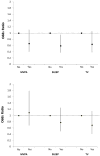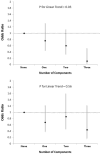Relationship Between Meeting 24-Hour Movement Guidelines and Cardiometabolic Risk Factors in Children
- PMID: 28556685
- PMCID: PMC5607096
- DOI: 10.1123/jpah.2017-0090
Relationship Between Meeting 24-Hour Movement Guidelines and Cardiometabolic Risk Factors in Children
Abstract
Background: The purpose of this study was to evaluate the relationship between adherence to pediatric 24-hour movement guidelines (moderate to vigorous physical activity, sedentary behavior, and sleep) and cardiometabolic risk factors.
Methods: The sample included 357 white and African American children aged 5-18 years. Physical activity, television viewing, and sleep duration were measured using questionnaires, and the 24-hour movement guidelines were defined as ≥60 minutes per day of moderate to vigorous physical activity on ≥5 days per week, ≤ 2 hours per day of television, and sleeping 9-11 hours per night (ages 5-13 y) or 8-10 hours per night (ages 14-18 y). Waist circumference, body fat, abdominal visceral and subcutaneous adipose tissue, blood pressure, fasting triglycerides, high-density lipoprotein cholesterol, and glucose were measured in a clinical setting.
Results: A total of 26.9% of the sample met none of the guidelines, whereas 36.4%, 28.3%, and 8.4% of the sample met 1, 2, or all 3 guidelines, respectively. There were significant associations between the number of guidelines met and body mass index, visceral and subcutaneous adipose tissue, triglycerides, and glucose. There were no associations with blood pressure or high-density lipoprotein cholesterol.
Conclusions: Meeting more components of the 24-hour movement guidelines was associated with lower levels of obesity and several cardiometabolic risk factors. Future efforts should consider novel strategies to simultaneously improve physical activity, sedentary time, and sleep in children.
Keywords: obesity; pediatrics; physical activity; sedentary behavior; sleep.
Figures


Similar articles
-
Associations Between Meeting the 24-Hour Movement Guidelines and Cardiometabolic Risk in Young Children.Pediatr Exerc Sci. 2021 May 13;33(3):112-119. doi: 10.1123/pes.2020-0249. Pediatr Exerc Sci. 2021. PMID: 33992028
-
Total volume versus bouts: prospective relationship of physical activity and sedentary time with cardiometabolic risk in children.Int J Obes (Lond). 2018 Oct;42(10):1733-1742. doi: 10.1038/s41366-018-0063-8. Epub 2018 May 1. Int J Obes (Lond). 2018. PMID: 29717272
-
Compliance With Physical Activity and Sedentary Behavior Guidelines and Associations With Abdominal Adiposity in a Sample of Infants and Toddlers From Soweto, South Africa.J Phys Act Health. 2019 Oct 1;16(12):872-879. doi: 10.1123/jpah.2018-0182. Epub 2019 Jul 17. J Phys Act Health. 2019. PMID: 31319404
-
The prospective association between objectively measured sedentary time, moderate-to-vigorous physical activity and cardiometabolic risk factors in youth: a systematic review and meta-analysis.Obes Rev. 2019 Jan;20(1):55-74. doi: 10.1111/obr.12758. Epub 2018 Sep 30. Obes Rev. 2019. PMID: 30270500
-
Combinations of physical activity, sedentary time, and sleep duration and their associations with depressive symptoms and other mental health problems in children and adolescents: a systematic review.Int J Behav Nutr Phys Act. 2020 Jun 5;17(1):72. doi: 10.1186/s12966-020-00976-x. Int J Behav Nutr Phys Act. 2020. PMID: 32503638 Free PMC article.
Cited by
-
Is adherence to the 24-hour movement guidelines associated with a reduced risk of adiposity among children and adolescents?BMC Public Health. 2020 Jul 16;20(1):1119. doi: 10.1186/s12889-020-09213-3. BMC Public Health. 2020. PMID: 32677940 Free PMC article.
-
How are 24-hour movement guidelines linked to health-related quality of life in Spanish children and adolescents?BMC Public Health. 2025 May 13;25(1):1760. doi: 10.1186/s12889-025-22998-5. BMC Public Health. 2025. PMID: 40361084 Free PMC article.
-
How do People Spend their Day? Sociodemographic Disparities in 24-hour Movement Guideline Adherence among US Adults Using 2017-2020 NHANES Data.J Racial Ethn Health Disparities. 2024 Aug;11(4):2346-2354. doi: 10.1007/s40615-023-01702-6. Epub 2023 Jul 10. J Racial Ethn Health Disparities. 2024. PMID: 37428356 Free PMC article.
-
Association between Sleep, Sedentary Time, Physical Activity, and Adiposity in Adolescents: A Prospective Observational Study.Med Sci Sports Exerc. 2023 Jan 1;55(1):110-118. doi: 10.1249/MSS.0000000000003018. Epub 2022 Aug 12. Med Sci Sports Exerc. 2023. PMID: 35977103 Free PMC article.
-
Post-meal exercise under ecological conditions improves post-prandial glucose levels but not 24-hour glucose control.J Sports Sci. 2024 Apr;42(8):728-736. doi: 10.1080/02640414.2024.2363688. Epub 2024 Jun 10. J Sports Sci. 2024. PMID: 38858835 Free PMC article. Clinical Trial.
References
-
- U.S. Department of Health and Human Services. 2008 Physical Activity Guidelines for Americans. Washington, DC: US Government Printing Office; 2008.
-
- World Health Organization. Global Recommendations on Physical Activity for Health. Geneva, Switzerland: World Health Organization; 2010. - PubMed
-
- Tremblay MS, Leblanc AG, Janssen I, et al. Canadian sedentary behaviour guidelines for children and youth. Appl Physiol Nutr Metab. 2011;36:59–64. - PubMed
Publication types
MeSH terms
Grants and funding
LinkOut - more resources
Full Text Sources
Other Literature Sources
Medical
Miscellaneous

